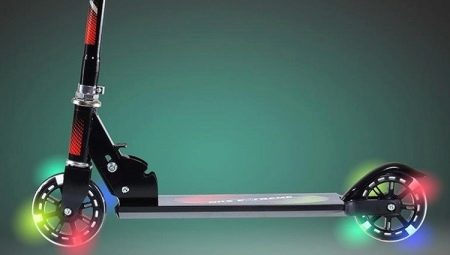Having learned to walk, a child from a pram moves on a scooter. This is the first mode of transport in which the child tries (and eventually learns) to ride independently. The principle of its action is as follows: the child takes the steering wheel in his hands, with one foot he stands on the deck, the other pushes off the ground and moves off.
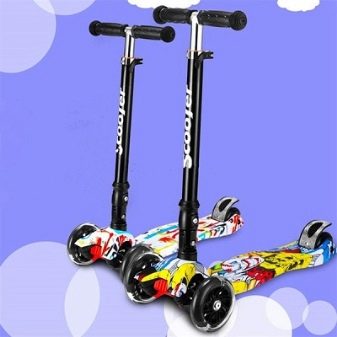
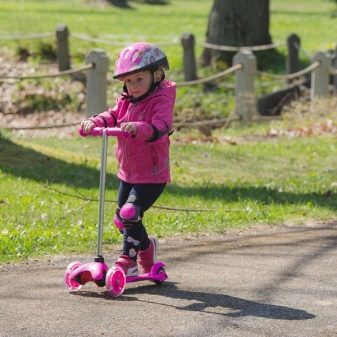
Advantages and disadvantages
Scooters with luminous wheels have their advantages.
- A child riding in a dark park with poor lighting can be seen all the time. He will not fall under the wheels of cyclists and will not crash into other scooters - even when their lights are off, they will all stop and / or turn off his road, noticing that he is riding. The most important thing is the safety of all participants in the movement.
- Scooter as a type of children's transport is the next step in the physical development of a growing child. Contrary to the stories told by the yellow press creators, walking in the fresh air on a scooter or bicycle is much longer, interesting and developing than just walking on foot. The growing child masters his first transport in his life - learns to drive wheeled vehicles. And the blinking and luminous wheels will make this process more joyful and fun for him.
The disadvantage of such wheels is that they need to be powered by LEDs. In general, placing the LEDs in the "shock" part, which accounts for the lion's share of the load, is not the best solution. It would be more correct to place them, for example, on the steering column.
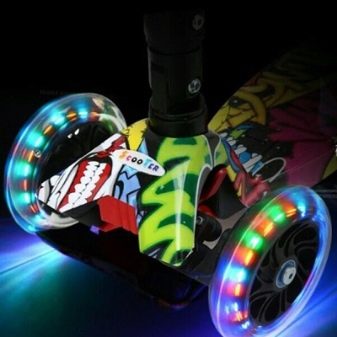
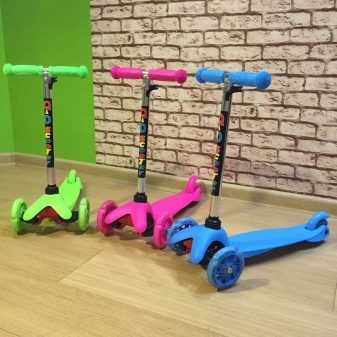
What makes the wheels glow?
The LEDs in the thickness of the colored transparent polyurethane from which the “shoe” of the scooter is made, which makes it possible to ride comfortably on it, glow due to electricity, the source of which is not batteries.Coils located in the moving part of the wheel are interconnected and with LEDs using wires.
Each of the coils produces current pulses, moving in the field of magnets located on a fixed axis. Old as the world, the principle of operation of the luminous wheel is the simplest dynamo on each of them, forcing the LEDs to glow continuously or blink.
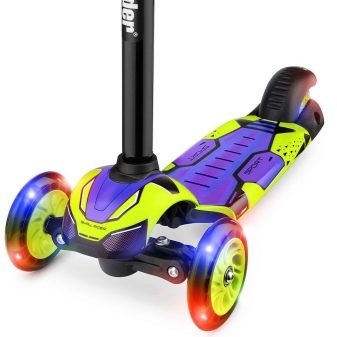

Sooner or later, these LEDs stop burning. There are several reasons for this.
- A single LED burned out. This often happens when a child accelerates on a scooter too quickly. The faster the wheel spins, the greater the voltage and current. LEDs degrade faster and lose brightness due to overvoltage by voltage and current - color and white have their own limits that cannot be exceeded. But try to explain this to the child - he doesn’t care how long they last, the main thing is speed.
- The magnet has rolled off, it has broken - a phenomenon due to the fact that the axis gradually developed. A weakened thinned magnet does not give the previous magnetic field. The required power has ceased to be generated, the LEDs glow pale or not all at once.
In some cases, it rotates with the wheel itself - this also does not produce current for the LEDs.
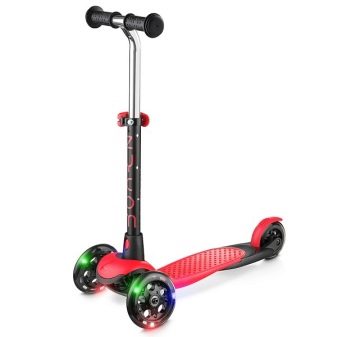
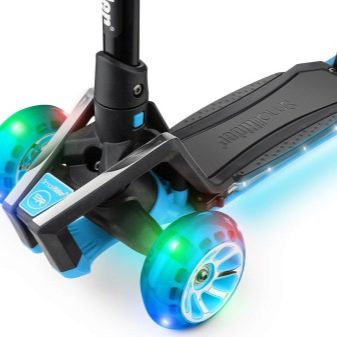
How to check and fix?
To return the glow to the wheels of the scooter, do one of the following:
- The loose torque on the wheel is tightened with hex wrenches suitable in size. This eliminates the spinning of the magnetic sleeve along with the wheel itself.
- The bearings are removed and the magnet itself is removed. A significantly damaged sleeve (and the magnet itself) needs to be replaced as quickly as possible. The lack of glow of the wheels is not so bad: a damaged sleeve and broken bearings jam the wheel. It is impossible to accelerate on such a scooter.
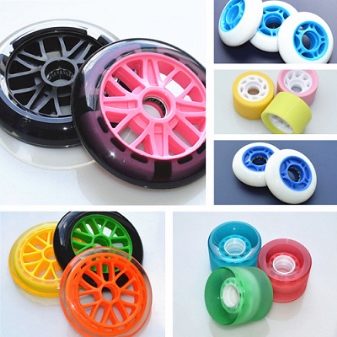
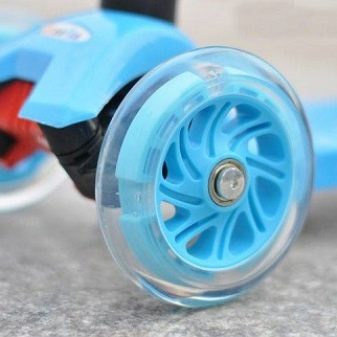
With the integrity of the parts of the sleeve and the entire wheel, they are washed from dust and dirt, remove the remnants of the old grease and stuff a new one into the mechanism. After that, the wheels spin regularly, and the glow will work again. When LEDs and coils fail, the wheel cannot be repaired - the entire current-carrying circuit is filled with special glue, like epoxy. Buy a new (same) wheel.
In order to avoid a new breakdown on a scooter that is not intended for tricks, it is forbidden to perform any acrobatic numbers.
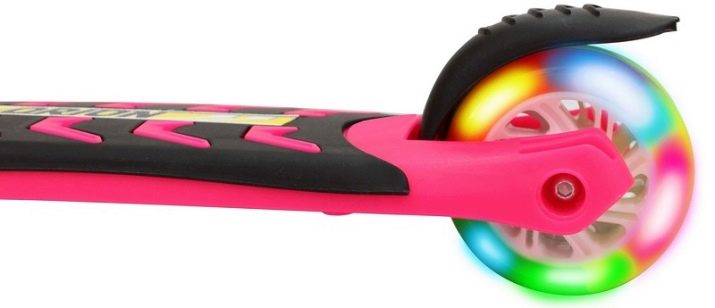
Species overview
Scooters are divided into several types according to the number of wheels.
- One wheel - has only one wheel. Balance and unobstructed riding are supported in a special way by a balanced frame and gyroscope controlled by a microcontroller with special microprogram. Not the last place in this is taken by the rider himself.
- Two wheeled - standard, oldest design in use history. Universal - regardless of the age of the owner. The lowest stability - in return makes it possible to accelerate almost to the speed of a skier. It requires skill and dexterity, as when riding a two-wheeled bicycle. Scooter, if you get to the office on it, you can leave it under your desktop or next to it. He is an excellent assistant when an adult tries to catch up with a bus, ready to leave the stop right this minute. Suitable for storage at home.
- Tricycle - Many beginners begin with it, who have not yet switched to a two-wheeled view. 3-wheel ones include zips, inertia scooters and flickers. The scooter is very reliable. Perfectly as well as as the main vehicle, allowing to develop the speed of a running person. It allows you to maintain balance - but it has a more cumbersome design; with it, not every office will let you in.
- Four-wheeled - also applies to inertia: it is actuated either by repulsion of one of the legs, or by means of rotational movements of the lower part of the body.
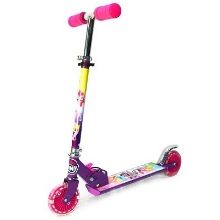
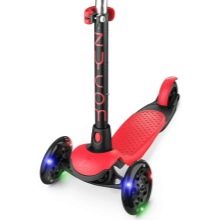
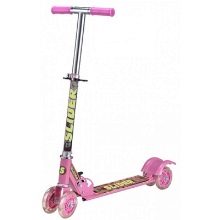
According to the size of the wheels, scooters are divided into products with large (200 or more millimeters), medium (145 or more) and small (125 or less, up to 70 or 80 mm) rotating parts.The larger the front and rear wheels, the more comfortable it is to ride on rough roads, alleys and paths.
On the floor of the child - scooters for boys and girls. Here, the colors and graphics applied to the product at the factory mainly decide. Theoretically, there should not be restrictions on the sex of a child or teenager on scooters - there is also a “unisex” model.
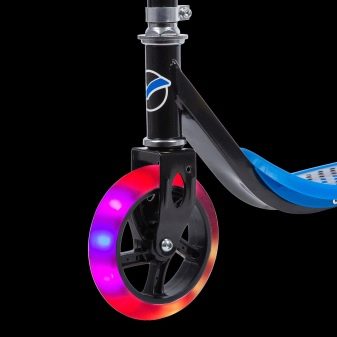

Design
Regardless of which of the colors (pink, blue, orange or green) is most often used to paint the frame, steering wheel or wheels, the product itself should be convenient and safe for the child. Let him choose the color for himself - you must control the safety (as a parent or donor). However, there are rules: give the boy a pink scooter - this action is not particularly welcomed by most people: choose more neutral shades, for example, between orange and blue.
Do not forget: from the injury due to the low-quality performance of the frame, bushings and scooter wheels, jamming brakes and not quite obedient steering wheel, no bright design will save.
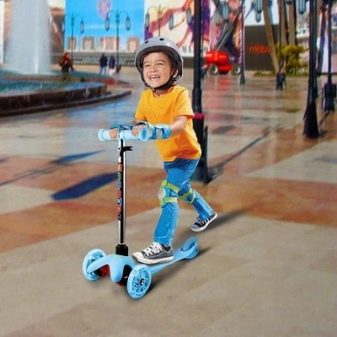
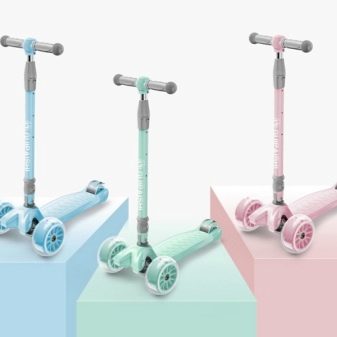
Manufacturers
Among the leading suppliers, the companies stand out: Stels, Scooter, Scoot & Ride, Midi Orion, Globber, Trolo, Pulsan, Kugoo and dozens of others. If you do not put design and special comfort at the forefront, such inexpensive samples can become good options for children and younger teens.
- 100LO. FOXX. RD7 - a children's two-wheeled scooter for riding in the yards of housing estates and in parks. Stainless steel frame for 4-6 year olds, child weight up to 60 kg. Folding model, foot brake, polyurethane wheels 100 mm in diameter (each), class ABEC-7 bearings. The rear wheel is doubled.
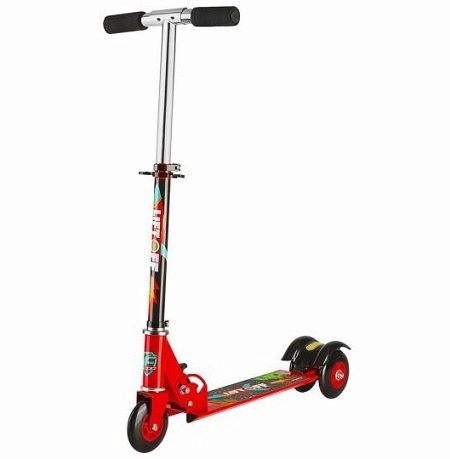
- Buggy boom alfa model - for children in 2-3 years. The maximum weight of a child is 25 kg. Foldable model with foot brake. The front wheel is 12 cm, the rear wheel is 10 cm in diameter. The height of the steering wheel is 67 cm. The weight of the product is 1.8 kg.
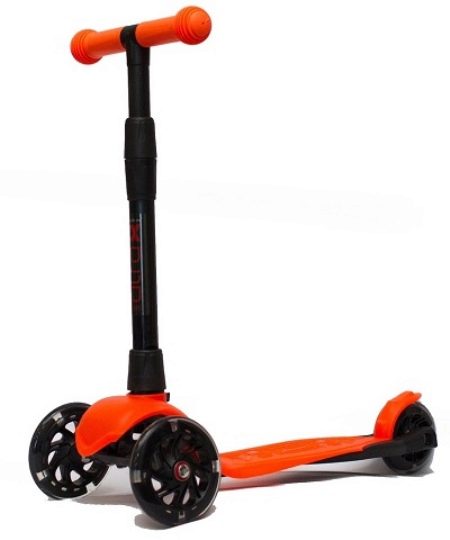
- Tech Team TT Duke 303 - for teenagers from 7 to 10 years. Weight - 3.3 kg. Steel frame and deck, two wheels with a diameter of 11 cm and a thickness of 24 mm. Teenager's weight is up to 60 kg. Designed for several years of active everyday use. The height of the steering wheel is from 58 cm, the width of the transverse steering stick is up to 49 cm. The footrest is 50 * 11.5 cm.
There are a huge number of Chinese fakes, for example, under Swiss Micro scooters, Russian Stels, etc.
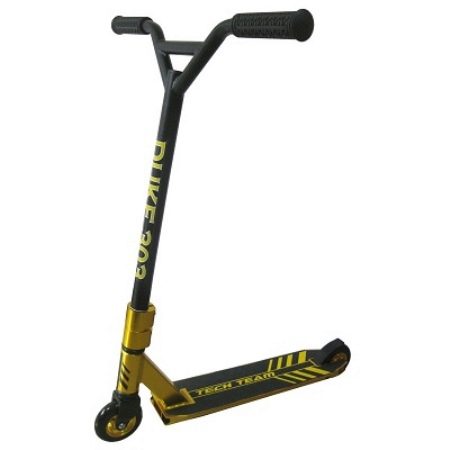
Criterias of choice
Scooter is the first type of self-used transport, from which even a one and a half year old child starts. Often, children, having barely learned how to walk, use scooters with seats: it is still difficult for them to stand and push off with their feet all the time while riding. Already at 3 years old, the child, possessing energy tearing out, not knowing the obstacles, directs her to ride a scooter. A scooter is the best alternative to a runbike. At 2 years old, a model with a 60-75-cm steering wheel height is suitable for the child. A three-year-old kid will suit both a model with one wheel in front and with two in the same place - this is a three-wheeled sports equipment that helps newcomers to easily maintain balance. It can be supplemented with a seat. The steering wheel remains at the same height.
At the age of 4–5 years, a product suitable for a weight of up to 30 kg and with a rudder height of 75–85 cm is suitable for a child. It has a 120 ... 125-mm wheel in front, while the rear wheels have a diameter of 70–80 mm. For comfort, they can be made of wear-resistant polyurethane or silicone. The width of the steering wheel reaches 270 mm. Such, for example, is the Scooter Mini model. At 4 or 5, you can freely switch to two-wheeled scooters - the child is already confidently running and will learn how to safely jump off the scooter.
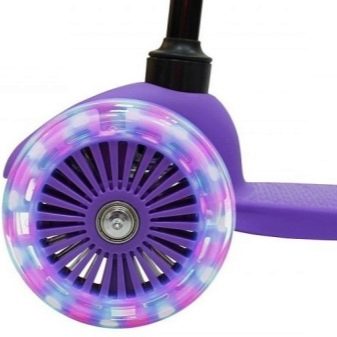
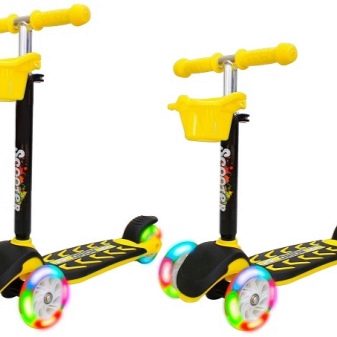
At the age of 6–10 years, the main differences are already erasing - the most universal option will be a scooter for 6-year-olds with steering wheel. This is the first scooter "for growth" in the life of a child - it will allow you to use it right up to 10 years. The size of the deck (supply for legs) should not be less than 10 cm wide - with a too narrow platform you can fly off at full speed and get injured or be thrown out of the scooter when hitting stones or cracks in the asphalt, chips and sagging sections of paving slabs, etc. d.
If for small children (up to 5 years old) a model with a plastic frame reinforced with metal structural elements will fit, then a scooter for 6 ... 10 year old children should be durable. And this is achieved only through the use of steel, aluminum-magnesium alloys and titanium parts. Being made of metal or alloy, the supporting structure will not put on weight so much that it would be difficult for the child to roll such a scooter back to the starting place, to bring it home. Scooters for children and teenagers of primary school age are quite light - they weigh no more than 3-4 kg.

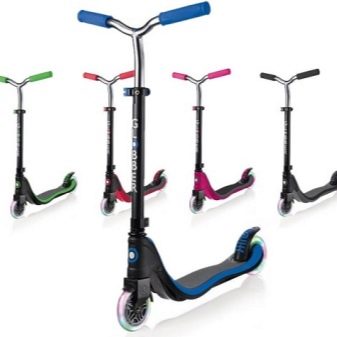
In the next video, you will find an overview of the children's folding three-wheeled scooter with luminous wheels 21st Scooter Maxi Micar Ultra.
